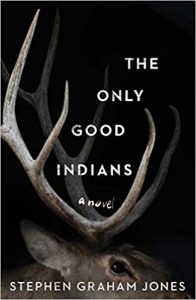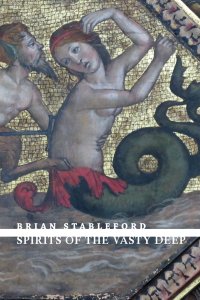Paula Guran Reviews The Only Good Indians by Stephen Graham Jones
 The Only Good Indians, Stephen Graham Jones (Saga Press 978-1-9821-364-51, $26.99, 320pp, hc) May 2020.
The Only Good Indians, Stephen Graham Jones (Saga Press 978-1-9821-364-51, $26.99, 320pp, hc) May 2020.
Good horror novels often have you reading and turning the pages as fast as you can. With a great horror novel – one that so arouses a sense of dread, connects so profoundly with that which is just beyond the normal world, is written with such superb craft and characterization that it draws you into the souls of the fictional beings – you sometimes read slowly. You are almost afraid to turn the page. I read The Only Good Indians by Stephen Graham Jones slowly.
The Only Good Indians is a great horror novel. Jones, long a prolific and notable sui generis writer, has written a masterpiece. Because this is the story of four men and the spirit of a vengeful female they killed as youths, I’m sure apt comparisons will be made to Peter Straub’s Ghost Story. Here, however the men are contemporary Blackfeet rather than old, almost-dead white guys. The book will be seen as effective “social commentary,” but it is not “commentary”: it is simply the truth displayed and injustice portrayed clearly for all to read. The publisher notes what it calls “cultural identity” while referencing other creators (like Jordan Peele and Tommy Orange). This may be appropriate, but they made their now-famous marks long after Jones started making his. The Only Good Indians is part of the same thematic and conscientious stream he’s been writing in all along. But whatever it takes to get the book to a wider audience is fine by this reviewer.
The core plot is deceptively simple: four young men kill the wrong elk in the wrong place. The transgression shapes who they become. How they are perceived by themselves and others is greatly influenced by the act. Ten years later, weird and deadly things begin to happen to them. But nothing is simple here, including the nature of reality (and the reality of nature). If your reality includes actual contact with entities and powers that other cultures consider unreal, yet is observable by those who do not share your way of life or belief, is it a natural rather than supernatural?
In his shorter work, Jones often concentrates on a single character, a character who is teetering on a precipice but doesn’t fall so much as slides across the border between “here” and “the other,” or from sanity to madness. The reader slips easily along with him, accepting and empathizing – or at least “understanding” to some extent – no matter how weird or brutal things get. The author often places his characters in the midst of life-shaping events or a discovery that reveals who and what they are – and that one never can get away from who and what they are. Jones offers all these themes (and others) in his novel. With more characters, of course, the narrative expands and encompasses so much more than the short form.
Set primarily in the contemporary Blackfeet Territory of Montana, the story is told from the viewpoints of each of the four fully portrayed main characters – Richard Boss Ribs (albeit briefly), Lewis Clarke, Cassidy Sees Elk, and Gabriel Cross Guns – and by their observations of one another, and those of other humans and a non-humans. Voices change but the narrative flows naturally with no confusion.
Supporting characters are just as well drawn, especially 16-year-old basketball phenom Denorah Cross Guns. Despite her young age, she already knows who she is and what must be done. And the basketball is right on the money, both its place in Indian Country and the game itself. There’s a life-and-death game of 21 that has to rank with the best fictional renderings of sport ever written.
The portrayal of the monster, Elk Woman, is also stunning. Her basis may be traditional, but she is a strikingly original beast: terrifying and unforgiving, yet poignant.
The book is, at times, visceral (literally), but it is as instinctive and essential as it is harsh. Despite the blood and bleakness, The Only Good Indians is ultimately also about hope and the promise of the future.
Read it. The Only Good Indians is a novel that will not only stay with you, it may alter your perceptions.
Paula Guran has edited more than 40 science fiction, fantasy, and horror anthologies and more than 50 novels and collections featuring the same. She’s reviewed and written articles for dozens of publications. She lives in Akron, Ohio, near enough to her grandchildren to frequently be indulgent.
This review and more like it in the March 2020 issue of Locus.
 While you are here, please take a moment to support Locus with a one-time or recurring donation. We rely on reader donations to keep the magazine and site going, and would like to keep the site paywall free, but WE NEED YOUR FINANCIAL SUPPORT to continue quality coverage of the science fiction and fantasy field.
While you are here, please take a moment to support Locus with a one-time or recurring donation. We rely on reader donations to keep the magazine and site going, and would like to keep the site paywall free, but WE NEED YOUR FINANCIAL SUPPORT to continue quality coverage of the science fiction and fantasy field.






